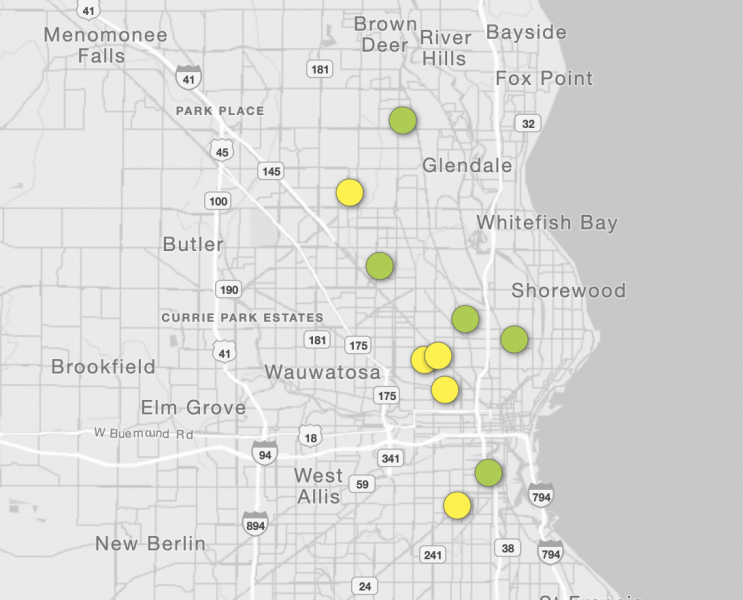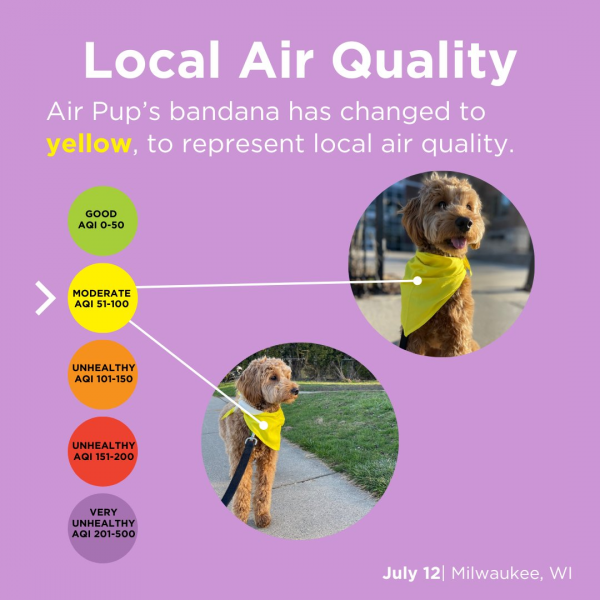Community Collaboration for Better Health
Milwaukee has long grappled with unsafe air quality and health disparities. With more than 25% of the population in poverty (double the national average), many of the city’s dense urban areas have older, unhealthy housing in close proximity to major transportation corridors. People living in these frontline neighborhoods often face additional health challenges such as poverty, lack of insurance, limited access to comprehensive healthcare and asthma care, lack of asthma education, limited access to affordable transportation, stress, trauma, and discrimination. This contributes to high asthma rates and mortality, especially among Milwaukee’s Black residents. Children, older adults, outdoor workers, and those with asthma are at the highest risk for complications from climate-fueled heat events and elevated air pollution.
Ongoing work between the Wisconsin Department of Health Services (DHS), the Wisconsin Department of Natural Resources (DNR), the Wisconsin Climate and Health Program, and the Wisconsin Asthma Program sprang into action in 2021, creating the Breathe SMART Collaborative, a joint effort focused on air quality and health messaging. Building off the collaborative’s efforts, The Children’s Health Alliance of Wisconsin, which was already deeply invested in the community, partnered with DHS on a pilot project with two Milwaukee Public Schools. The goal was to install outdoor air quality sensors on school buildings and use them to monitor efforts to reduce vehicle idling during school drop-off and pick-up times. To evaluate the pilots’ success, an air monitoring expert in DHS’s Site Evaluation Program and evaluators from CHP and the WI Asthma Program worked to validate the air quality data.
Once the air monitoring project received grant funding from the Environmental Protection Agency (EPA), the Alliance was able to bring Sarah Kroening on board in 2023 as the program manager. Her task was to bring the full school-based air quality initiative to life. Leveraging her expertise as an educational specialist for children with complex medical issues, she was inspired by the project's goal of raising awareness about how air pollution affects health–especially respiratory conditions such as asthma. The Wisconsin Climate and Health Program would continue to work side-by-side with Sarah, providing technical assistance in checking air quality and evaluation.
Breathing Life into “Love My Air”
The pilot project provided insights that the Alliance eventually used to strengthen and grow the program. Looking for ways to enhance engagement and education, they turned to their partners at “Love My Air” in Denver, CO, aligning with their mission to provide communities with visible, accessible, and actionable air quality information nationwide.
The team incorporated the previous anti-idling and neighborhood air monitoring work with broader educational initiatives, adapting the framework of Denver’s “Love My Air” program to meet the needs of their own community. They chose to use PurpleAir air quality sensors to gather real-time air quality data at each school and engage the community in taking actionable steps to avoid health risks. Sarah expanded the Alliance’s existing community ties, bringing participating schools and other local entities together with a common focus on children’s health, air quality, and education. She also created elementary-level lesson plans to make the information accessible for teachers to use in the classroom. Playworks, an organization that teaches leadership and responsibility through play, became a key partner in creating engaging activity guides to promote healthy play across all levels of the air quality index.
Connections between Air Quality and Climate
The sensors used by LoveMyAir measure tiny particles in the air that are 2.5 microns or smaller in size. These particles, refered to as PM2.5 come from sources such as vehicle emissions, industrial processes, wildfires, and the burning of fossil fuels. When we burn fossil fuels, not only do we release heat-trapping gases that contribute to climate change, but we also produce PM2.5. Climate change can make air quality worse by increasing wildfires, which release large amounts of PM2.5 into the air, and by creating weather patterns that trap pollution near the ground. In turn, higher levels of PM2.5 can harm human health by causing respiratory and heart problems. So, while PM2.5 isn't a direct cause of climate change, the two are linked through their common sources and effects on the environment and health.
A New Class of Air Quality Champions
Today, Sarah runs “Love My Air Wisconsin” with flexibility and creativity as her guiding principles.“ Every day is something new,” she said. “We’re learning along the way, so I love that. I love being an educator. I love being creative.” During the 2023-2024 school year, the program served five elementary schools. Sarah spent her days visiting them, checking that the air sensors were working properly, creating lesson plans, and sharing engaging resources on air pollution and asthma. As the program evolves, she and her partners continually seek new ways to enhance engagement and impact.
Five more schools will join the program in the upcoming school year, bringing the cohort of “Love My Air Wisconsin” participants to a total of six K-5th grade schools, three K-8th schools, and one high school. Students will become the key players in sharing information with their parents and community. Each school will be encouraged to select a small team of students, called “champions,” who are eager for participation and leadership opportunities. These champions can share air quality data with their peers, learn how to protect themselves and their communities, and teach others about air pollution health risks and solutions. By next spring, champions from each school will be equipped and ready to share their knowledge in public awareness campaigns they design. The role of a champion can be tailored to fit the needs of individual students at each school. By encouraging student-led initiatives, Sarah hopes to foster a sense of leadership and readiness among kids to spread the word across the city using the Love My Air app.
The Future of Love My Air
Looking forward, Sarah and the Wisconsin Climate and Health and Asthma Programs envision a future where the Love My Air Wisconsin initiative becomes a model that can be replicated across the whole state. The goal is to install air quality sensors on school buildings across Wisconsin to create a comprehensive air quality network, supplementing existing air quality data and enhancing community awareness through kid-friendly education in both rural and urban areas. Sarah is also working toward developing sustainable funding models to ensure the program’s longevity. Their dream is to create an air quality program that drives collective actions among schools and their communities to enhance children's health based on local data. As the “Love My Air Wisconsin” program continues to evolve, it stands as a testament to what can be achieved when passion, expertise, and community collaboration come together for a common cause. This dynamic program not only monitors air quality but also empowers students and community members to take an active role in their health as it relates to air quality. With a vision of expanding to more communities for years to come, Sarah and her partners are paving the way for a future where every child in Milwaukee and beyond is equipped with the tools to breathe easier knowing how they can protect themselves.
Learn More and Get Involved
The Children’s Health Alliance of Wisconsin’s website offers valuable resources for anyone who wants to learn more or get involved with Love My Air. From educational lesson plans to an outdoor activity guide, anyone can use the resources to become an air quality champion. Love My Air is also active on social media (@chawisconsin on Instagram), where the loveable Air Pup can be spotted wearing colored bandanas to indicate local air quality conditions.




